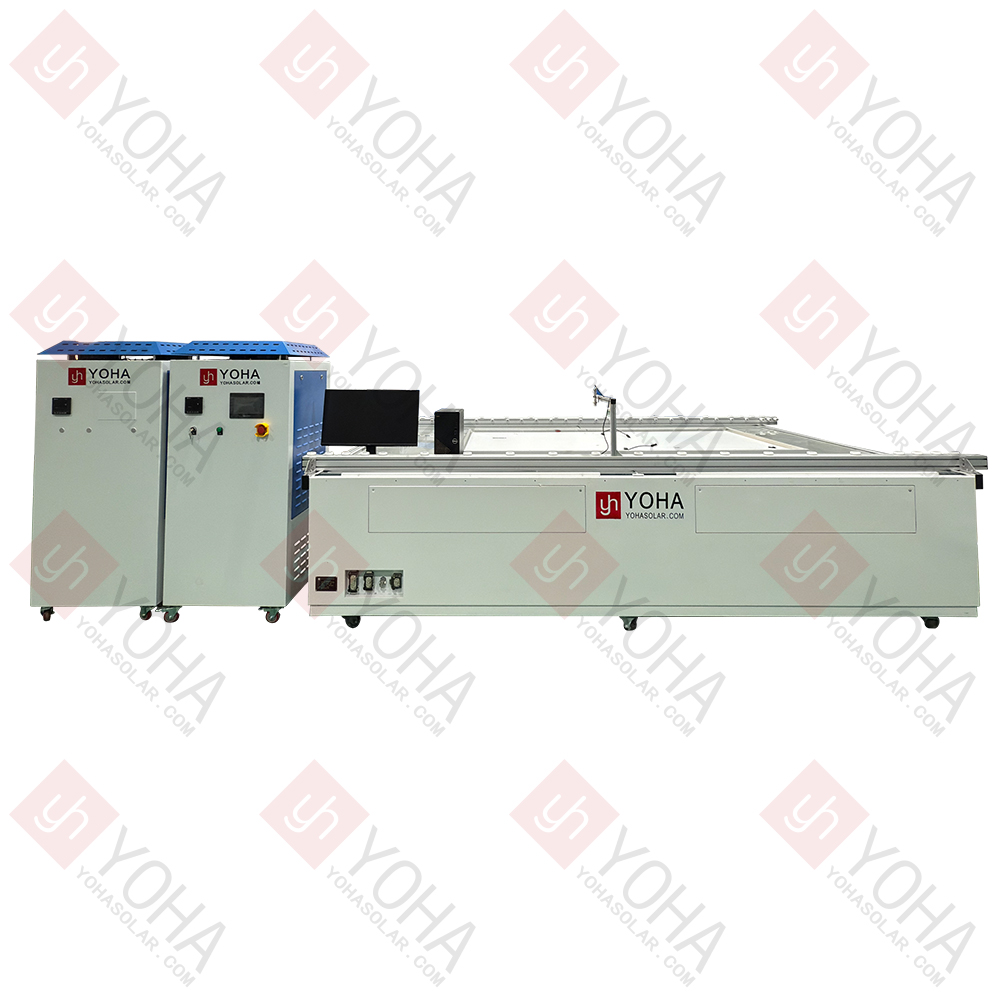Welcome to Wuhan Yoha Solar Technology Co., Ltd!
common problem
Site Map
Language:
 Chinese
Chinese
 English
English
Welcome to Wuhan Yoha Solar Technology Co., Ltd!
common problem
Site Map
Language:
 Chinese
Chinese
 English
English
The Large-Size BIPV Module IV Tester is a high-precision testing device specifically developed for the increasingly popular large-size and irregularly shaped modules in the Building-Integrated Photovoltaics (BIPV) field. It comprehensively measures current-voltage (IV) characteristic curves, power output, efficiency, and key mismatch parameters (such as hot spot effects) to accurately verify the actual power generation performance, long-term reliability, and safety of these special modules in complex building-integrated environments (e.g., non-uniform illumination, temperature gradients, partial shading). It features strong physical compatibility (large size, curved surfaces, transparent area handling) and high-power load capacity to meet stringent requirements for laboratory R&D, production line quality control, and partial post-installation field inspection.

Exceptional Physical Compatibility: Designed specifically for BIPV modules larger than 3.5m×2.3m, including curved, transparent, and irregular shapes. Equipped with adjustable fixtures and a flexible contact system for non-destructive and precise adaptation.
Realistic Environmental Simulation Testing: Integrates adjustable illumination (200-1200W/m²) and temperature measurement platforms to simulate lighting conditions, temperature gradients, and low-light scenarios. Intelligently diagnoses hot spots and mismatch risks.
High-Precision IV & Safety Verification: Current and voltage measurement accuracy reaches ±0.8%. Comprehensively acquires 23 key parameters (e.g., Voc, Pmax). Integrates DC 3000V insulation withstand voltage and leakage current monitoring to ensure electrical safety in building applications.
Full-Scenario Intelligent Application: Seamlessly covers laboratory R&D (multi-variable analysis), high-speed full inspection on production lines (15 seconds/module), and on-site acceptance (portable split design). Generates cloud-based performance degradation models via IoT, empowering full lifecycle management.
| Item | Parameter |
|---|---|
| Model Specification | YHMT-3523 |
| Light Source | Complies with IEC60904-9:2020 Spectral Requirements (Class A) |
| Spectral Range | 300~1200nm |
| Irradiance | 1000W/㎡ (200~1200W/㎡) |
| Light Intensity Non-Uniformity | ≤2% (A) |
| Light Intensity Instability | ≤2% (A) |
| Test Result Consistency | ≤1% |
| Electrical Performance Measurement Error | ≤2% |
| Single Flash Pulse Width | 100ms |
| Effective Test Area | 3500*2300mm |
| Power Supply | 220V/50HZ |
1. BIPV Module R&D Verification: Serves photovoltaic laboratories and research institutes. Precisely quantifies the IV characteristics of irregular modules (curved/transparent) in simulated building environments (dynamic lighting, temperature variation, shading), supporting the iterative design of new BIPV materials and structures.
2. Full-Process Production Line Quality Control: Integrated into PV manufacturing lines. Completes power binning, hot spot screening, and safety performance (insulation/withstand voltage) full inspection for oversized modules within 15 seconds, ensuring zero-defect delivery for building-integrated applications.
3. Construction Site Acceptance Assessment: Adaptable for high-altitude/confined space operations. Retests IV curves of installed BIPV facades and roofs using portable split equipment to verify transportation and installation losses, ensuring initial system performance meets standards.
4. Building Operation & Maintenance Fault Diagnosis: Periodically connects to the cloud database. Compares historical IV data to intelligently locate degradation anomalies (e.g., hot spot deterioration, wiring faults), providing decision-making basis for preventive maintenance of building PV systems.
1. Prioritize Safety Protection: Before testing, confirm the module has no hidden cracks, moisture, or exposed wires. Wear insulated gear during operation. For ultra-high-power modules (>800W), activate arc-proof mechanisms to avoid breakdown risks during DC 3000V withstand voltage tests.
2. Ensure Precision with Strict Environmental Control: Operate in a darkroom environment (ambient light <50 lux) and stable temperature (25±2°C) to avoid light interference and temperature drift errors. For outdoor field tests, record real-time irradiance/temperature data simultaneously for result correction.
3. Confirm Special Module Adaptation: For curved, transparent, or flexible BIPV modules, use customized non-contact probes or low-pressure fixtures (pressure ≤5N/cm²) to prevent structural damage or poor test contact.
4. Preset Parameters to Match Scenarios: Enable multi-peak IV scanning mode for building shadow tests. Switch to high-sensitivity measurement ranges in low-light environments (<200W/m²) to avoid data distortion. Activate leakage current monitoring function during safety tests.
5. Intervene Immediately for Data Anomalies: If the IV curve shows sudden drops, multiple steps, or negative slopes, interrupt testing immediately and check for module hot spots, shading, or wiring faults. Calibrate equipment if the fluctuation of three consecutive test results exceeds >±1.5%.
6. Regular Maintenance of Key Modules: Clean optical simulator filter monthly (prevent dust-induced irradiance attenuation). Calibrate high-precision source meters quarterly (if accuracy drift >±0.5%). Replace probe wear parts annually (discard if contact resistance >10mΩ).
TOP
18086473422
MESSAGE
